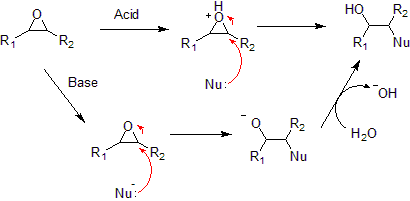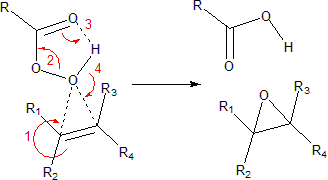Difference between revisions of "Epoxide" - New World Encyclopedia
(imported latest version of article from Wikipedia) |
(added credit and category tags, deleted foreign language links) |
||
| Line 57: | Line 57: | ||
{{reflist}} | {{reflist}} | ||
| − | [[Category: | + | [[Category:Physical sciences]] |
| − | [[Category: | + | [[Category:Chemistry]] |
| − | |||
| − | + | {{credit|228534668}} | |
| − | |||
| − | |||
| − | |||
| − | |||
| − | |||
| − | |||
| − | |||
| − | |||
| − | |||
| − | |||
Revision as of 17:44, 5 September 2008
An epoxide is a cyclic ether with only three ring atoms. This ring approximately is an equilateral triangle, i.e. its bond angles are about 60°, which makes it highly strained. The strained ring makes epoxides more reactive than other ethers, especially towards nucleophiles. Simple epoxides are named from the parent compound ethylene oxide or oxirane, such as in chloromethyloxirane. As a functional group epoxides obtain the epoxy prefix such as in the compound 1,2-epoxycycloheptane which can also be called cycloheptene epoxide.
A polymer containing unreacted epoxide units is called a polyepoxide or an epoxy. Epoxy resins are used as adhesives and structural materials. Polymerization of an epoxide gives a polyether, for example ethylene oxide polymerizes to give polyethylene glycol, also known as polyethylene oxide.
Synthesis
Epoxides are usually created by one of the following reactions:
Olefin peroxidation
Olefin peroxidation, also known as the Prilezhaev reaction [1][2] involves the oxidation of an alkene with a peroxide, usually a peroxyacid like m-CPBA or with a dioxirane like DMDO. An example is the epoxidation of styrene with perbenzoic acid to styrene oxide:[3]
The reaction proceeds via what is commonly known as the Butterfly Mechanism.[4] It is easiest to consider the oxygen to be an electrophile, and the alkene a nucleophile, although they both operate in that capacity, and the reaction is considered to be concerted (the numbers in the mechanism below are for simplification).
Related processes include some catalytic enantioselective reactions, such as the:
- Sharpless epoxidation
- Jacobsen epoxidation
- Shi epoxidation
Intramolecular SN2 substitution
This method is a variant of the Williamson ether synthesis. In this case, the alkoxide ion and the halide are right next to each other in the same molecule (such compounds are generically called halohydrins), which makes this a simple ring closure reaction. For example, with 2-chloropropanol:[5]
Johnson-Corey-Chaykovsky reaction
In the Johnson-Corey-Chaykovsky reaction epoxides are generated from carbonyl groups and sulfonium ylides.
Reactions
Typical epoxide reactions are listed below.
- Nucleophilic addition to an epoxide can be base or acid catalyzed.

- Under acidic conditions, the nucleophile attacks the carbon that will form the most stable carbocation, i.e. the most substituted carbon (similar to a halonium ion). Under basic conditions, the nucleophile attacks the least substituted carbon, in accordance with standard SN2 nuclephilic addition reaction process.
- Hydrolysis of an epoxide in presence of an acid catalyst generates a glycol. The hydrolysis process of epoxides can be considered to be the nucleophilic addition of water to the epoxide under acidic conditions.
- Reduction of an epoxide with lithium aluminium hydride and water generates an alcohol. This reduction process can be considered to be the nucleophilic addition of hydride (H-) to the epoxide under basic conditions.
- Reduction with tungsten hexachloride and n-butyllithium generates the alkene. This reaction in effect is a de-epoxidation:[6]
See also
- polyethers
ReferencesISBN links support NWE through referral fees
- ↑ Template:JerryMarch
- ↑ Nikolaus Prileschajew (1909). Oxydation ungesättigter Verbindungen mittels organischer Superoxyde. Berichte der deutschen chemischen Gesellschaft 42 (4): 4811–4815.
- ↑ Harold Hibbert and Pauline Burt (1941). "Styrene Oxide". Org. Synth.; Coll. Vol. 1: 494.
- ↑ Bartlett Rec. Chem. Prog 1950, 11 47.
- ↑ Koppenhoefer, B.; Schurig, V. (1993). "(R)-Alkyloxiranes of High Enantiomeric Purity from (S)-2-Chloroalkanoic Acids via (S)-2-Chloro-1-Alkanols: (R)-Methyloxirane". Org. Synth.; Coll. Vol. 8: 434.
- ↑ K. Barry Sharpless, Martha A. Umbreit, Marjorie T. Nieh, Thomas C. Flood (1972). Lower valent tungsten halides. New class of reagents for deoxygenation of organic molecules. J. Am. Chem. Soc. 94 (18): 6538-6540.
Credits
New World Encyclopedia writers and editors rewrote and completed the Wikipedia article in accordance with New World Encyclopedia standards. This article abides by terms of the Creative Commons CC-by-sa 3.0 License (CC-by-sa), which may be used and disseminated with proper attribution. Credit is due under the terms of this license that can reference both the New World Encyclopedia contributors and the selfless volunteer contributors of the Wikimedia Foundation. To cite this article click here for a list of acceptable citing formats.The history of earlier contributions by wikipedians is accessible to researchers here:
The history of this article since it was imported to New World Encyclopedia:
Note: Some restrictions may apply to use of individual images which are separately licensed.


